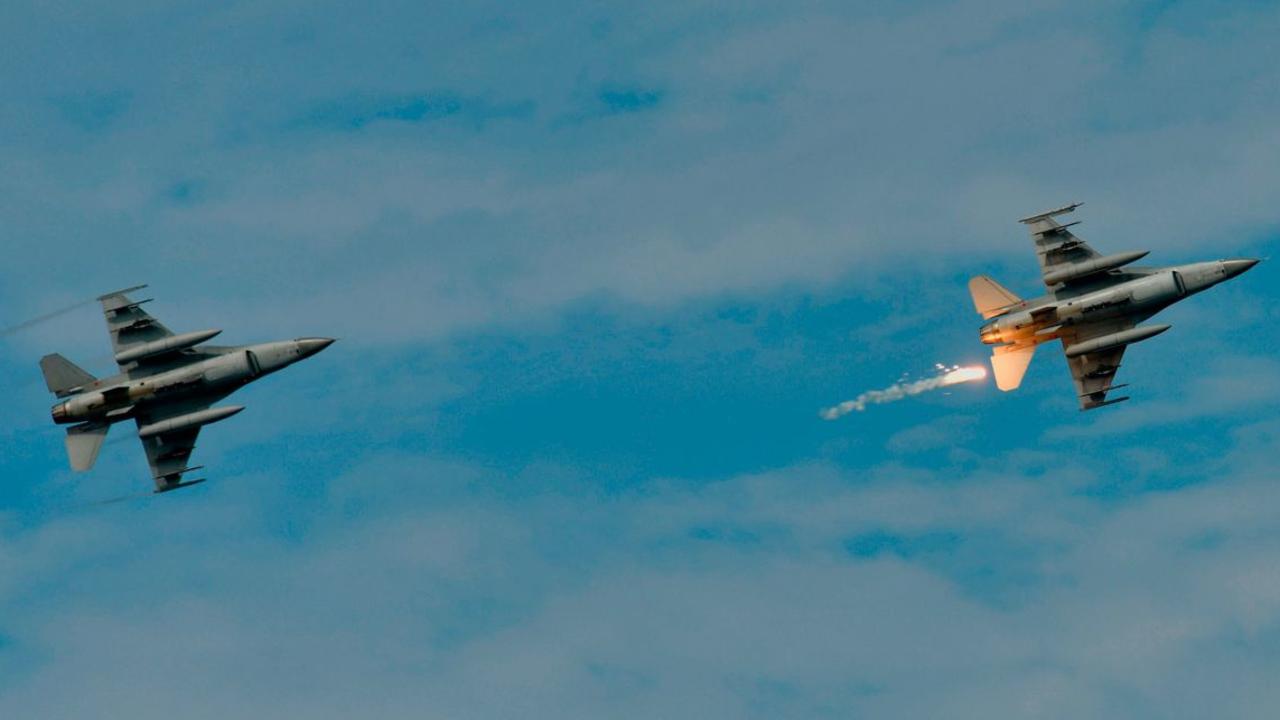Taiwan scrambles fighter jets in response to China’s ongoing assault
A tired Taiwan has scrambled fighters and activated defence missile systems as China’s air assault claims its first victims.
China’s unrelenting air assault on Taiwan has claimed its first victims – that nation’s defence and home affairs ministers.
The People’s Liberation Army (PLA) air force shows no sign of releasing the pressure on Taiwan.
Instead, it has continued its recent escalation of sending bombers and long-range fighters along with surveillance aircraft over the tiny Taiwanese Pratas Atoll at the northern tip of the South China Sea.
Taiwan scrambled fighters and activated air defence missile systems in response to a probe combat aircraft Friday and another on Saturday – just hours after a military reshuffle.
RELATED: China launches jets as dispute escalates

International military analysts say the incursions – which have dramatically increased in size and frequency – is intended to wear down Taiwan’s defences and place pressure on its leadership.
That pressure is beginning to bear fruit.
RESHUFFLE
Taiwan’s Defence Department has a new minister, Chiu Kuo-Cheng. Chiu received much of his military training at the United States Army War College in Pennsylvania.
The office of President Tsai Ing-wen issued a statement saying Chiu will implement military reforms. These included planning for “asymmetric warfare” and “grey zone” warfare – focusing on hi-tech, mobile weapons designed to make any Chinese attack as difficult as possible.
RELATED: ‘Fire’: South China Sea at boiling point
Nine PLA aircraft (J-16*4, JH-7*4 and Y-9 EW) entered #Taiwan’s southwest ADIZ on Feb. 19, 2021. Please check our official website for more information: https://t.co/FHz3QVdQCSpic.twitter.com/YbI6NrC67h
— 國防部 Ministry of National Defense, R.O.C. 🇹🇼 (@MoNDefense) February 19, 2021
Chen Ming-tong takes Chiu’s vacated space as intelligence chief at the National Security Bureau.
“The most important task of the National Security Bureau is to understand and have a grasp on China,” the President’s office said.
The new Mainland Affairs Council head – Chiu Tai-san – has been labelled “dovish” towards the mainland by the now Beijing-controlled South China Morning Post.
Former defence minister Yen Te-fa has taken up a position on the national security council.
The reshuffle is seen as an attempt to appease both Washington and Beijing. Taiwan’s President Tsai Ing-wen faces the possibility of US President Joe Biden seeking to de-escalate tensions across the Taiwan Strait. She also faces increased hostility from Beijing over the popularity of her pro-democracy presidency.
RELATED: ‘Ludicrous’: US piles pressure on China
11 PLA aircraft (J-10*2, J-16*2, JH-7*4 , JH-7*2 and Y-8 ASW) entered #Taiwan’s southwest ADIZ on Feb. 20, 2021. Intelligence indicates this to be PLA’s annually joint exercise, which we keep monitoring at all time. More information on: https://t.co/huP8p0rAEqpic.twitter.com/Jlm8gjMdTF
— 國防部 Ministry of National Defense, R.O.C. 🇹🇼 (@MoNDefense) February 20, 2021
“As long as Tsai and the DPP authorities do not accept the one-China principle, Beijing will not change its existing policies just because of some superficial changes,” the South China Post reports CCP international affairs analyst Xin Qiang as saying.
The Biden administration, however, is not signalling any intention to backdown on its pro-Taiwan position. After the weekend air incursions, the US State Department repeated its call for Beijing “to cease its military, diplomatic and economic pressure against Taiwan”. Instead, it should “engage in meaningful dialogue with Taiwan’s democratically elected representatives”.
PRATAS FLASHPOINT
Just hours after the reshuffle, Taiwanese interceptors were scrambled.
On Friday, four Chinese J-16 long-range fighters and four JH-7 fighter-bombers, as well as an electronic warfare aircraft, entered the air defence identification zone near Pratas.
On Saturday, 11 aircraft – including eight J-16 fighters, two nuclear-capable H-6 bombers and an anti-submarine aircraft – made a similar probe.
Taiwan’s Defence Ministry said its fighters were sent into the air, “radio warnings issued and air defence missile systems deployed to monitor the activity”.
Taiwan’s air force has been seeking to purchase replacements for its ageing F-16 Falcon fleet from the US for several years. Washington recently approved a program to refurbish their engines and avionics.
Beijing has been sending its long-range bomber and fighter force on regular circumnavigations of Taiwan in recent years. Military analysts widely believed it was a tactic designed to degrade the Taiwan air force’s effectiveness and preparedness.
More recently, Beijing has focused its attention on the coral atoll off the coast of Hong Kong. Both Beijing and Taipei claim the Pratas island group. But the mostly uninhabited islets were never surrendered by the Republic of China (ROC) after the civil war of 1949. They have remained a source of tension ever since.
The new democratic Taiwan maintains a small military garrison there, despite its 400km distance from the mainland. But its strategic position at the top of the South China Sea was emphasised when Beijing launched a simulated air strike against the USS Theodore Roosevelt aircraft carrier in January. Chinese H-6K bombers had to enter Pratas’ airspace in order to get within missile range of the aircraft carrier sailing near the Spratly Islands after transiting the narrow strait between Taiwan and the Philippines.
Such overflights are now an almost daily event.
Jamie Seidel is a freelance writer | @JamieSeidel




